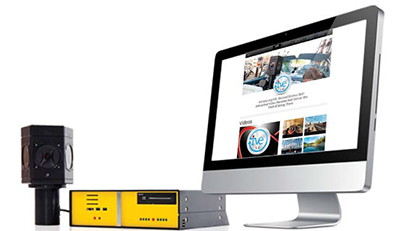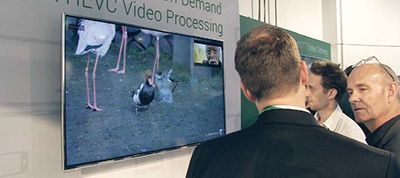Interest in OTT Heats Up
NEW YORK—As Netflix and Comcast collaborate to increase the speed of Netflix downloads over the nation’s largest ISP, and sales of streaming boxes rise, it’s no wonder FCC Chairman Tom Wheeler called the delivery of over-the-top content “the hottest thing in the media business today.”

Unified Video Technologies’ 360-degree IVE Interactive Video Service for OTT OTT, which includes the delivery of video, audio and other media over the Internet without a multiple system operator’s involvement and arrives from a third party, was truly one of the hot trends discussed at this year’s NAB Show and is only expected to increase. OTT falls into two main camps: the “Pureplay” offerings that include streaming services such as Netflix, Hulu and Amazon Prime; and the “TV Everywhere” subscriber-authenticated services being offered by pay-TV providers and includes HBO Go, DirecTV Everywhere, Dish Anywhere and Comcast’s Xfinity.
THE AEREO FACTOR
Consumers can now access OTT content through a variety of IP-connected devices including computers, tablets, smartphones, smart TVs and game consoles, and even via third-party set-top boxes such as the Roku or Apple TV or dongles such as Google’s Chromecast.
According to research from ABI Research, the OTT video market passed $8 billion in 2012 and is predicted to reach more than $20 billion next year. This is why an OTT battle could head to the Supreme Court, as ABC, CBS, Fox and NBC look for a final showdown with Aereo, the Barry Diller-financed startup that streams broadcast signals over IP. Broadcasters contend that Aereo is stealing their respective content and then offering it through Aereo’s streaming service over the Web for a fee. Aereo has countered that it is merely a complement to online video services.
While PBS and ABC already offer some streaming options and both are available through OTT solutions such as Apple TV, CBS—according to a report in the Wall Street Journal—has hinted that if Aereo wins in the courts it could provide its own online streaming service that would be simultaneous with its TV broadcasts. Last year during its battle with Aereo, Fox even threatened to pull its broadcast signal and go to an subscription service, but the practicality of such a move to an internet-only broadcaster would require different operational workflow, and require the creation of a new relationship with station viewers. This hasn’t been tried before, but even some pay-TV channels are responding with OTT solutions.

At the 2014 NAB show, Elemental Technologies demoed 4Kp60 HEVC video processing at its booth. ABC, Fox and NBC already have a significant presence with Netflix competitor Hulu, which is owned by their respective parent companies of Walt Disney Co., 21st Century Fox and Comcast Corp. Hulu currently offers its content via an on-demand service and doesn’t offer sports telecasts or local news programming. Further blurring the lines between broadcast and OTT, NBC earlier this month announced that it will develop a new series specifically for release on Hulu, apparently taking a cue from the original programming offered on Netflix and Amazon.com.
Currently HBO provides such an offering to its subscribers via its HBO Go service, but it remains to be seen whether OTT is truly ready for primetime as the season finale of “True Detective” and the season premiere of “Game of Thrones” both crashed the service. In other words, it has yet to be seen if OTT can truly be ready for primetime.
Get the TV Tech Newsletter
The professional video industry's #1 source for news, trends and product and tech information. Sign up below.
The growing popularity of OTT content creates a dilemma for traditional media and entertainment organizations, which “face increasing challenges as the consumer demand for content grows to match the affordability and broader access of the devices people use to stay connected,” said Tim Mendoza, vice president of product development at Imagine Communications, formerly Harris Broadcast. “Today’s content delivery isn’t the linear, over-the-air procedure of yesterday. Developing and maintaining internal systems that address the multiplatform requirements of each content provider is a problem that has outgrown traditional software development processes and timelines. Creating reusable, easily scalable workflows that prepare and transform large quantities of content is as important as managing development and implementation costs today while predicting maintenance expenses down the road.”
Another challenge facing broadcasters today is how to deploy OTT services in an efficient and cost-effective manner that does not disrupt existing workflows and systems already in place.
Such needs “require a platform for unified management of content, rights and ad sales across all services, with the scalability to remain cost-effective as needs evolve, through features such as support for multiple CDNs and transcoding technologies,” said Alon Weinberg, vice president of business development OTT market and OTTilus at Pilat Media. “The key is to approach and manage OTT as a component of the core business, rather than a separate, siloed function.”
Pilat’s OTTilus can enable these services to be managed through a single operation and a single repository for content, rights, ad inventory, and offers. “Therefore, broadcasters can introduce lucrative new OTT services into their operations while minimizing delivery time, optimizing available resources and maximizing profits,” Weinberg added.
FIRST IN 4K?
OTT could also mean higher resolution content in the future, and Netflix is first out of the gate with this month’s launch of the second season of its hit series “House of Cards”—as well as some nature documentaries— in 4K HD. The service is being provided on a limited basis to TVs with Netflix and HEVC/H.265 decoding capabilities built in.
“We are very excited about Ultra HD 4K because it is the first time that the best quality video will be primarily delivered via the Internet, as opposed to a physical delivery format,” said Joris Evers, Netflix spokesperson. “That’s why we’re at the forefront of Ultra HD 4K and ready to start streaming a limited set of titles as soon as new TVs capable of receiving and decoding our Ultra HD 4K streams hit store shelves.”
Evers said that streaming in Ultra HD 4K will require a broadband connection that delivers consistent speeds of 20 Mbps or higher. “We are using HEVC H.265 to encode and deliver the new format. As a result we can stream at a bitrate around 15 Mbps,” he said. “We also continue our efforts to partner with ISPs to deliver the best possible Netflix experience.”
The reach of Netflix is also still going strong. According to a recent study from Parks Associates, 86 percent of Roku owners use a subscription OTT service of one kind or another, with 75 percent of them choosing Netflix.
Until Netflix’s Ultra HD service officially launches, there will be questions about how well streaming OTT services, including Netflix, can actually handle such bandwidth-intensive traffic accordingly (although an early review of the service in the “Wall Street Journal” last week was generally positive). According to recent studies Netflix now accounts for nearly 30 percent of all Internet traffic at peak hours, and if that’s not enough, according to Cisco, video will occupy 85-90 percent of all global consumer broadband traffic by 2017.
OTT for Multiscreen
OTT will also continue to change the way content is viewed, especially due to the growth of TV Everywhere. “In the next two-three years, all services will be available in multiscreen,” Tim Mendoza, vice president of product development for Imagine Communications. “Many operators and content originators tested the water in the last two years and are ready to convert to an all IP, all ABR, TV Everywhere service. The acquisition of Imagine Communications and Digital Rapids has allowed the company [Harris Broadcast] to serve the linear and nonlinear, multiscreen market while rounding out our end-to-end portfolio with an integrated offering for both linear and nonlinear requirements.

“Our highly dense, scalable and operationally efficient TV Everywhere portfolio enables customers to deliver optimized experiences across multiscreen environments,” added Mendoza. Imagine’s products targeting this market include SelenioNext, featuring adaptive bit rate (ABR) transcoding technology and the SelenioEdge content delivery network (CDN) software which, according to Mendoza, have “combined to create an end-to-end, TV Everywhere solution to meet growing demand for optimized live video stream distribution across a variety of platforms.”
—Peter Suciu
The back-to-back crashes of HBO’s OTT service suggest it isn’t quite ready for yet more eyeballs, and given that 4K will require a faster broadband connection, the issue becomes whether this will only increase the problems.
Premium content will require premium subscriptions, according to Edgar Moyano, business development manager at Miami-based Unified Video Technologies, which offers white-label OTT-based VOD solutions. “Most of the content will be delivered directly to 4K smart TV sets, at least in the beginning,” he said. “We’ve been seeing greater use of content delivery networks, which from the network point of view can deliver 4K. However, it will be another charge for the users because the bandwidth required for that asset is going to be higher. So it will become a premium service. The issue is how the market will absorb that price.”
The result could be that service operators will need to deliver through the CDN, but Moyano added, “4K is going to take someone to manage the bandwidth at anytime, at any second. The CDN will help handle that, and there will surely be middle-wear to help manage it more.”
EARLY STAGES OF THE MARKET
That middlewear is now just coming into play. At the NAB Show, German-based Opticom premiered its PEVQ-S, which provides a new analysis technique for OTT video quality measurement, benchmarking and optimization. According to its developers it will leapfrog shortcomings that are currently observed for standardized video quality measurements when it comes to adaptive bit-rate streaming OTT services. PEVQ-S pushes proven standards-based perceptual measurement of video quality beyond the constraints of snapshots containing just a few seconds, allowing long-term quality characterization of OTT video service delivery in IP networks.
PEVQ-S is just one area where the market is being to show signs of increasing maturity.
“Fundamentally in terms of 4K across the board we’re in the early stages of the market,” said Keith Wymbs, chief marketing officer at Portland, Ore.-based Elemental, which supplies HEVC technology for use in mobile video and 4K Ultra HD programming. “This is regardless of the segment of the market, whether it is cable or satellite or OTT.”
Wymbs added that getting to the next generation video compression standard is one of the bigger issues right now.
“For so long video has been stuck with MPEG-2, which was adopted in the 1980s and now everything on the Internet is HEVC H.264. We’re looking to that next generation of HEVC,” Wymbs said. It is that technology that Netflix already plans to support with its 4K content delivery. “Every generation reduces the bit rate by 40 to 50 percent, which adds the capacity to have additional resolution and quality but at a lower bit rate,” Wymbs added. “This really allows the video to be delivered and streamed more cost effectively. This is important when you deliver OTT on a CDN, which charges by the bit. It simply reduces the operational costs.”
